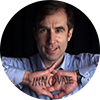I’m very excited to bring you this expert round up post. I asked 13 change management experts for their top three tips anyone wanting to implement fast, dramatic and powerful change. Here are my broad takeaways:
- Communication/collaboration, engaging stakeholders in the very creation of the vision and change processes.
- You need to focus on people, changing their behaviour not your own methods and processes.
- Change requires focus and discipline. It is way to easy to succumb to the drift and slide into mediocrity.
13 change management experts share tips on how to implement fast, dramatic and powerful change
Read on to discover each expert’s response. You can skip ahead to your favourite expert with the links below and please, get comfortable and read through all the great responses.
 John P Kotter
John P Kotter Jason Little
Jason Little Kate Nasser
Kate Nasser Tripp Braden
Tripp Braden Mike Brown
Mike Brown Mark Graban
Mark Graban Braden Kelley
Braden Kelley Alli Polin
Alli Polin Gregg Brown
Gregg Brown Craig Reid
Craig Reid Janelle McLaughlin
Janelle McLaughlin Malati Shinazy
Malati Shinazy Tina Schuelke
Tina Schuelke
John P Kotter
- Dramatic and powerful is not going to happen unless you develop a true sense of urgency about the opportunity offered by the changes, and urgency that is intellectual and emotional, and among lots of people. Ultimately, you are going to need a lot of people to help, not just resist.
- You need to start demonstrating some successes asap to develop credibility, and momentum, to start to win over the sceptical.
- You have to approach all the work with the question of sustainability in the front of your mind. Is what we are doing going to show results for a while but then start to slide back to the old way?

Jason Little
When it comes to deep, transformational change, more is more. That is, we think it’s wasteful to have everyone in the room when it comes to aligning people around the change so we end up separating the ‘thinkers from the doers’ because it’s the most efficient. The thinkers carry the message to the doers, and then we’re surprised when people don’t understand why.
- Everyone who will live with the day-to-day consequence of the change needs to be involved with designing it.
- Piggybacking on Point 1, visualizing the change is the gift that keeps giving. Stop burying change project details in online tools, and start using big visible walls. It’s cheap, simple, and even for large changes in multiple locations, they’re easy to take pictures of, or even duplicate. Simple is better!
- Once the people affected by the change have had a hand in designing it, and the work is visualized, establish new rituals in front of the big visible walls. That replaces your communication strategy with something meaningful, allows you to ditch status reports that no one is reading and forces more meaningful conversations.
There will always be a new trendy change model that comes and goes, but at the end of the day deep, meaningful conversations is the only way to create fast, dramatic and powerful change in today’s organizations.

Kate Nasser
- Communicate early and clearly. If you want change to be dramatic and fast, don’t surprise your employees. Fast doesn’t mean being thrown off a cliff. Give them details so they can see it isn’t just a lot of talk.
- Inspire them with vision don’t blame them for past events that precipitated the impending change. Show them you believe in what the change will do. If you don’t believe in it why should they?
- Involve them. Reach ’em don’t preach’em. Ask their concerns and work with them to create solutions. When people have a sense of control in their daily lives, it reduces anxiety and resistance.

Tripp Braden
- Empower others to act and use their unique gifts, strengths, and life experience to achieve lasting organisational change. Always strive to make each change initiative better than the last in planning, execution, and results.
- Make sure communications easily flow up and down the organisation to help reward those who are acting. Create and support ongoing communication strategies to help the organization better understand what is happening throughout the change process.
- Engage people across the organisation to help become positive catalysts for your change efforts. Learn how to reward positive change efforts publicly and transparently. Learn continuously from each phase to improve future outcomes.

Mike Brown
- Make sure you understand the dynamics of the environment before you formulate your change strategy. Those dynamics impact the scale of change and your best strategic options. Assessing the perceived need for dramatically different results and the underlying frustration with the status quo helps identify the most appropriate strategy.
- Involve the voices challenging the need for change. If challengers have open minds and are willing to participate in a positive way, they can dramatically improve change management results.
- No matter how much you communicate change and provide time to prepare, members of key audiences will struggle with accepting change and not perform well. No matter whether intentionally or unintentionally, their post-change performance will fall short of the ideal; that means you must keep reinforcing change on an ongoing basis.

Mark Graban
Far too often, it seems “change management” is an exercise in convincing people to accept our solution. I think effective change management starts earlier than the solution phase.
- Make sure there is agreement that there is a problem to solve or something that can be made better. If you can’t get alignment at this level, pushing a solution is probably going to be fruitless.
- Ensure there is a general consensus that things can be made better. If a majority of people think “that’s the way it’s always going to be,” they aren’t likely to engage in discussion about any solution.
- Engage people early in the solution creation process. Better yet, get them involved in understanding the current state or the “before” picture. The earlier you can engage people, the better. It might not be realistic to get everybody’s input, but be sure to select a core team that’s representative of the larger group.

Braden Kelley
If your change effort or project begins in a Microsoft Word document, you’re already in a whole world of trouble. Change is a human endeavor, so the most powerful way to embark on creating a dramatic and powerful change on an aggressive timeline is to surface the key challenges and opportunities as early as possible.
That doesn’t happen with a single individual tapping away at the keys entering prose or data into a traditional project charter. Instead, I recommend taking the following three steps to accelerate your change effort or project and increase its chances of success:
- Evaluate the Change Readiness of Your Organization
Too often we just jump in and announce the start of projects and change initiatives without even looking around to see if the resources that are going to be crucial to our success are even available.
Convene a cross-functional change planning team to identify the resources you are going to need to successfully complete the project (physical, financial, human, etc.). Then begin to draft an initial high level project schedule including when different resources will need and map that against their availability (including their commitments to other existing and potential projects and change initiatives) to create a change readiness heat map.
My PCC Change Readiness Framework and Worksheet from the Change Planning Toolkit™ are also useful tools for evaluating your change readiness.
- Architect Your Organization for Change
One of the biggest barriers to successful change initiatives is viewing change management as a subset of project management when we should really all be instead viewing project management as a subset of change management, and but one of Five Keys to Successful Change.
Consciously approaching the design of our organization and how it operates from the outside as changes in the environment dictate changes inside our organization can benefit from using a tool like the Architecting the Organization for Change framework.
-
Develop a Holistic View of the Change You’re Trying to Make
Change planning should never be a solo activity. You must identify those individuals who can verbalize the current and desired states, the risks and resources, identify the potential barriers and benefits, craft effective communications, etc.
You need to also involve people who know how to leverage a human-centered approach to affecting change using The Eleven Change Roles and who can build and maintain momentum by understanding and harness The Eight Change Mindsets that cause people to choose change.
I truly believe that only by taking a more visual, collaborative approach to change and capturing the key information on a single page using the Change Planning Canvas™ as you build your change plan, will you ever create and sustain the alignment necessary to beat the 70% change failure rate.

Alli Polin
- Take away the options. If people can still stick with the tried and true, they will. Make sure there’s a cutover and stick to it.
- Do more than pushing your solution, go on a listening tour. It’s easy to say “out with the old and in with the new!” but for people throughout the organization it causes stress and uncertainty. Two-way communication is essential. Spend time listening to concerns, challenges, ideas and suggestions without selling the change. Leaders may assume they know the pain the change will cause but that’s not always true.
- Involve people at all levels. Top down change can be powerful and dramatic but not always the most effective. Create opportunities for people to get involved, step up, and be a part of what’s next instead of having it simply happen to them. Let them help lead the way forward.

Gregg Brown
- Sharing the benefits and rationale and expecting people to get on board with the change isn’t realistic! Make sure to discuss benefits and concerns; and remember no one is ‘change ready’ (even if they logically understand the benefits and rationale) if the impact on them, or people they care about, is negative.
- If you manage expectations it will help avoid disappointment. Don’t be afraid to tell people what’s really going on to help manage their expectations. Sometimes as change leaders we think we need to have all the answers. Being honest about what you don’t know manages expectations and builds trust.
- Tell people what will stay the same. Whether the change is good or bad, people still need to feel a certain amount of control. Create a sense of stability by informing people of the changes and what is likely to remain the same (or similar) to the current state.
- Build a culture of resilience. Ryan Holiday’s excellent book “The Obstacle is the Way” should be essential reading for everyone in today’s organisations. It’s all about teaching your brain to see obstacles as opportunities and to plough through life. These are the kind of attributes that employees need to have to survive. Change will not go away it will only accelerate. Not only do organisations need to build resilience into their employees they need to look for it as a key attribute in their recruitment strategy.
- Focus change on the customer, not on the employee. It’s easy for employees to react negatively when the change is focussed on them. It’s harder for them to argue with when the change is focussed on making things better for the customer. Of course, you can make change to both at the same time, but focussing on doing the right thing by the customer at the same time will help to diffuse the emotional reaction of employees.
- Make staff an interim part of the design phase. Change is never something that should be “done” to a staff member, it’s something they should be a part of. Often the mistake that projects make is to dictate the way things are going to be. This infuriates staff who rebel against the change. Getting staff involved as early as possible with re-designing their own work and keeping them involved throughout the implementation will ensure that staff don’t slump into negative behaviours. Always facilitate – never dictate. You can grab a free copy of Craig’s Book The Process Revolution – Transforming Your Organisation with Process Improvement at https://processigroup.com.au/free-book/

Janelle McLaughlin
- Create a strong vision in place by leadership that is effectively and continuously communicated.
- Implement job-embedded, ongoing professional development.
- Come from a culture of trust and respect that is well-established prior to change implementation.

Malati Shinazy
In organizational systems theory, we operate with the knowledge that a change in one part of an organization will effect every part of that organization.
Since organizational change seldom happens by absolute surprise, preplanning each step of the process can ensure that change implementation will happen smoothly and be sustainable.
Below are three tips to help reach your change implementation goals.
- Plan for the impact the change will have on all stakeholders as early as possible.
Ideally, you will have time to get stakeholder input as part of your planning process. And, all key change agents will know their roles, milestones, and KPIs.Create a marketing, communication, and support plan for employees, customers, vendors, investors, and other stakeholders. Then, keep stakeholders informed with as much information as often as possible both before, during and after the change is complete. - Plan for the actual rollout of the change.
Good example: when banks are changing core systems, they conduct trial runs with mock-banks, filled with sample customers. They implement the change with the mock-bank as final beta tests multiple times before “flipping the switch.” - Plan for risk mitigation.
All changes come with some degree of risk. Attempt to identify likely risks and what actions will be taken when a “what if” situation occurs.Without a risk mitigation plan, you endanger the organization. Not only will your change initiative falter or fail but the fall-out may cause organizational fires that will suck the air out of the organization itself.

Tina Schuelke
My top three priorities (a must-do, can’t fail list) for implementing fast, dramatic, and powerful change in an organization are these:
-
- Get a real perspective of what the current state is from each stakeholder, or stakeholder group’s viewpoint.
a. Do not judge as right or wrong, accept this as their reality (even though their perspective may not be complete or all encompassing)
b. Understand what about the current state will work to your change’s advantage, and what about it is causing barriers to the change.
-
- Introduce the change to each stakeholder group in words and stories and results they can relate to.
a. A one meeting to suit all, so everyone hears the exact same thing approach never works.
b.Be clear, concise, and consistent in your facts, but address WIIFT (what is in it for them) specific to each stakeholder group audience.
c. Get feedback to see if you are creating a common language and understanding of the change or if you need to address gaps in understanding or misunderstandings.
-
- Recognise and celebrate all the small steps of progress others make in the direction you need to go.
a. A simple acknowledgement of what you see and an authentic, spoken or written, “Thank You for (insert specific action or result)” goes a very long way in creating and sustaining momentum.
b.Resistors will notice and often become followers wanting the positive recognition, too, or at least feel a want to be one of the in-crowd.
c. A sincere and specific thank you along with a target for what you need to see next is often a great catalyst to achieve the next milestone.
To round out this roundup, here are my guiding tips I use with my clients and projects:
- Vision.Co-create create a compelling vision with an urgent case for change which articulates why change now, what opportunities will be missed if we don’t change and what risks will we be exposed to.
- Buy-in & Relationships. Enroll anyone and everyone into this vision. Ask for their commitment. Engage the key influencers in the organisation. These are the people with the combination of expertise and informal influence.
- Structure & integrity. Create a plan and operating rhythm. Carve out time and space to create the change in people’s diaries. Leadership from the top down must walk the talk, demonstrating the change in real time. The change leadership team must do what they said they’d do. Keep commitments.


